Synthesis of Monodisperse Mesoporous Carbon Spheres/EPDM Rubber Composites and Their Enhancement Mechanical Properties
Abstract
:1. Introduction
2. Materials and Methods
2.1. Chemicals
2.2. Synthesis of Monodisperse Mesoporous Carbon Sphere
2.3. Synthesis of MCS/EPDM Rubber Composites
2.4. Characterization and Performance Tests
2.4.1. Characterization
2.4.2. Testing of the MCS/EPDM Rubber Composites
2.4.3. Coarse-Grained Molecular Dynamics Simulation
3. Results
3.1. Characterization of Mesoporous Carbon Spheres
3.2. Morphology of the Foams
3.3. Specific Surface Area and Pore Size Analysis of Mesoporous Carbon Spheres
3.4. Mechanical Properties
4. Conclusions
Author Contributions
Funding
Data Availability Statement
Acknowledgments
Conflicts of Interest
References
- Gatos, K.G.; Karger-Kocsis, J. Effects of Primary and Quaternary Amine Intercalants on the Organoclay Dispersion in a Sulfur-Cured EPDM Rubber. Polymer 2005, 46, 3069–3076. [Google Scholar] [CrossRef]
- Auer, E.; Freund, A.; Pietsch, J.; Tacke, T. Carbons as Supports for Industrial Precious Metal Catalysts. Appl. Catal. A Gen. 1998, 173, 259–271. [Google Scholar] [CrossRef]
- Yang, R.; Song, Y.; Zheng, Q. Payne Effect of Silica-Filled Styrene-Butadiene Rubber. Polymer 2017, 116, 304–313. [Google Scholar] [CrossRef]
- Cai, H.-H.; Li, S.-D.; Tian, G.-R.; Wang, H.-B.; Wang, J.-H. Reinforcement of Natural Rubber Latex Film by Ultrafine Calcium Carbonate. J. Appl. Polym. Sci. 2003, 87, 982–985. [Google Scholar] [CrossRef]
- Sreelekshmi, R.V.; Sudha, J.D.; Menon, A.R.R. Novel Organomodified Kaolin/Silica Hybrid Fillers in Natural Rubber and Its Blend with Polybutadiene Rubber. Polym. Bull. 2017, 74, 783–801. [Google Scholar] [CrossRef]
- Sun, Y.; Ma, K.; Kao, T.; Spoth, K.A.; Sai, H.; Zhang, D.; Kourkoutis, L.F.; Elser, V.; Wiesner, U. Formation Pathways of Mesoporous Silica Nanoparticles with Dodecagonal Tiling. Nat. Commun. 2017, 8, 252. [Google Scholar] [CrossRef]
- Wu, M.; Li, L.; Liu, J.; Li, Y.; Ai, P.; Wu, W.; Zheng, J. Template-Free Preparation of Mesoporous Carbon from Rice Husks for Use in Supercapacitors. New Carbon Mater. 2015, 30, 471–475. [Google Scholar] [CrossRef]
- Zhang, X.; Zhong, C.; Lin, Q.; Luo, S.; Zhang, X.; Fang, C. Facile Fabrication of Graphitic Mesoporous Carbon with Ultrathin Walls from Petroleum Asphalt. J. Anal. Appl. Pyrolysis 2017, 126, 154–157. [Google Scholar] [CrossRef]
- Xia, X.; Cheng, C.-F.; Zhu, Y.; Vogt, B.D. Ultrafast Microwave-Assisted Synthesis of Highly Nitrogen-Doped Ordered Mesoporous Carbon. Microporous Mesoporous Mater. 2021, 310, 110639. [Google Scholar] [CrossRef]
- Saito, N.; Aoki, K.; Usui, Y.; Shimizu, M.; Hara, K.; Narita, N.; Ogihara, N.; Nakamura, K.; Ishigaki, N.; Kato, H. Application of Carbon Fibers to Biomaterials: A New Era of Nano-Level Control of Carbon Fibers after 30-Years of Development. Chem. Soc. Rev. 2011, 40, 3824–3834. [Google Scholar] [CrossRef]
- Deshmukh, A.A.; Mhlanga, S.D.; Coville, N.J. Carbon Spheres. Mater. Sci. Eng. R Rep. 2010, 70, 1–28. [Google Scholar] [CrossRef]
- Du, J.; Liu, Z.; Li, Z.; Han, B.; Sun, Z.; Huang, Y. Carbon Onions Synthesized via Thermal Reduction of Glycerin with Magnesium. Mater. Chem. Phys. 2005, 93, 178–180. [Google Scholar] [CrossRef]
- Wang, Z.L.; Yin, J.S. Graphitic Hollow Carbon Calabashes. Chem. Phys. Lett. 1998, 289, 189–192. [Google Scholar] [CrossRef]
- Wei, Z.; Ren, H.; Wang, S.; Qiu, H.; Liu, X.; Jiang, S. Facile Preparation of Well Dispersed Uniform, Porous Carbon Microspheres and Their Use as a New Chromatographic Adsorbent. Mater. Lett. 2013, 105, 144–147. [Google Scholar] [CrossRef]
- Szadkowski, B.; Marzec, A.; Zaborski, M. Effect of Different Carbon Fillers on the Properties of Nitrile Rubber Composites. Compos. Interfaces 2019, 26, 729–750. [Google Scholar] [CrossRef]
- Shakun, A.; Sarlin, E.; Vuorinen, J. Material-Related Losses of Natural Rubber Composites with Surface-Modified Nanodiamonds. J. Appl. Polym. Sci. 2020, 137, 48629. [Google Scholar] [CrossRef]
- Mokhireva, K.A.; Svistkov, A.L.; Solod’ko, V.N.; Komar, L.A.; Stöckelhuber, K.W. Experimental Analysis of the Effect of Carbon Nanoparticles with Different Geometry on the Appearance of Anisotropy of Mechanical Properties in Elastomeric Composites. Polym. Test. 2017, 59, 46–54. [Google Scholar] [CrossRef]
- Vozniakovskii, A.A.; Vozniakovskii, A.P.; Kidalov, S.V.; Otvalko, J.; Neverovskaia, A.Y. Characteristics and Mechanical Properties of Composites Based on Nitrile Butadiene Rubber Using Graphene Nanoplatelets. J. Compos. Mater. 2020, 54, 3351–3364. [Google Scholar] [CrossRef]
- Li, F.; Lu, Y.; Liu, L.; Zhang, L.; Dai, J.; Ma, J. Relations between Carbon Nanotubes’ Length and Their Composites’ Mechanical and Functional Performance. Polymer 2013, 54, 2158–2165. [Google Scholar] [CrossRef]
- Kresge, C.T.; Leonowicz, M.E.; Roth, W.J.; Vartuli, J.C.; Beck, J.S. Ordered Mesoporous Molecular Sieves Synthesized by a Liquid-Crystal Template Mechanism. Nature 1992, 359, 710–712. [Google Scholar] [CrossRef]
- Zhao, D.; Feng, J.; Huo, Q.; Melosh, N.; Fredrickson, G.H.; Chmelka, B.F.; Stucky, G.D. Triblock Copolymer Syntheses of Mesoporous Silica with Periodic 50 to 300 Angstrom Pores. Science 1998, 279, 548–552. [Google Scholar] [CrossRef] [PubMed]
- Ryoo, R.; Joo, S.H.; Jun, S. Synthesis of Highly Ordered Carbon Molecular Sieves via Template-Mediated Structural Transformation. J. Phys. Chem. B 1999, 103, 7743–7746. [Google Scholar] [CrossRef]
- Tang, J.; Liu, J.; Li, C.; Li, Y.; Tade, M.O.; Dai, S.; Yamauchi, Y. Synthesis of Nitrogen-doped Mesoporous Carbon Spheres with Extra-large Pores through Assembly of Diblock Copolymer Micelles. Angew. Chem. Int. Ed. 2015, 54, 588–593. [Google Scholar] [CrossRef] [PubMed]
- Wang, G.; Sun, Y.; Li, D.; Liang, H.; Dong, R.; Feng, X.; Müllen, K. Controlled Synthesis of N-doped Carbon Nanospheres with Tailored Mesopores through Self-assembly of Colloidal Silica. Angew. Chem. 2015, 127, 15406–15411. [Google Scholar] [CrossRef]
- Wang, Q.; Li, H.; Chen, L.; Huang, X. Monodispersed Hard Carbon Spherules with Uniform Nanopores. Carbon 2001, 39, 2211–2214. [Google Scholar] [CrossRef]
- Eyssa, H.M.; Afifi, M.; Moustafa, H. Improvement of the Acoustic and Mechanical Properties of Sponge Ethylene Propylene Diene Rubber/Carbon Nanotube Composites Crosslinked by Subsequent Sulfur and Electron Beam Irradiation. Polym. Int. 2023, 72, 87–98. [Google Scholar] [CrossRef]
- Shojaei Dindarloo, A.; Karrabi, M.; Hamid, M.; Ghoreishy, R. Various Nano-Particles Influences on Structure, Viscoelastic, Vulcanization and Mechanical Behaviour of EPDM Nano-Composite Rubber Foam. Plast. Rubber Compos. 2019, 48, 218–225. [Google Scholar] [CrossRef]
- Yagyu, H. Simulations of the Effects of Filler Aggregation and Filler-Rubber Bond on the Elongation Behavior of Filled Cross-Linked Rubber by Coarse-Grained Molecular Dynamics. Soft Mater. 2017, 15, 263–271. [Google Scholar] [CrossRef]
- Yagyu, H.; Utsumi, T. Coarse-Grained Molecular Dynamics Simulation of Nanofilled Crosslinked Rubber. Comput. Mater. Sci. 2009, 46, 286–292. [Google Scholar] [CrossRef]
- Zhong, B.; Zeng, X.; Chen, W.; Luo, Q.; Hu, D.; Jia, Z.; Jia, D. Nonsolvent-Assisted Surface Modification of Silica by Silane and Antioxidant for Rubber Reinforcement. Polym. Test. 2019, 78, 105949. [Google Scholar] [CrossRef]
- GB/T 6344-2008; Flexible cellular polymeric materials—Determination of tensile strength and elongation at break. Standardization Administration of the People’s Republic of China: Beijing, China, 2008.
- GB/T 10808-2006; Flexible cellular polymeric materials—Determination of tear strength. Standardization Administration of the People’s Republic of China: Beijing, China, 2006.
- GB/T 6669-2008; Flexible cellular polymeric materials—Determination of compression set. Standardization Administration of the People’s Republic of China: Beijing, China, 2008.
- Toepperwein, G.N.; Karayiannis, N.C.; Riggleman, R.A.; Kröger, M.; De Pablo, J.J. Influence of Nanorod Inclusions on Structure and Primitive Path Network of Polymer Nanocomposites at Equilibrium and Under Deformation. Macromolecules 2011, 44, 1034–1045. [Google Scholar] [CrossRef]
- Gong, Y.; Xie, L.; Li, H.; Wang, Y. Sustainable and Scalable Production of Monodisperse and Highly Uniform Colloidal Carbonaceous Spheres Using Sodium Polyacrylate as the Dispersant. Chem. Commun. 2014, 50, 12633–12636. [Google Scholar] [CrossRef]
- Titirici, M.-M.; Antonietti, M.; Baccile, N. Hydrothermal Carbon from Biomass: A Comparison of the Local Structure from Poly- to Monosaccharides and Pentoses/Hexoses. Green Chem. 2008, 10, 1204–1212. [Google Scholar] [CrossRef]
- Álvarez-Láinez, M.; Rodríguez-Pérez, M.A.; de Saja, J.A. Acoustic Absorption Coefficient of Open-Cell Polyolefin-Based Foams. Mater. Lett. 2014, 121, 26–30. [Google Scholar] [CrossRef]
- Fang, Y.; Gu, D.; Zou, Y.; Wu, Z.; Li, F.; Che, R.; Deng, Y.; Tu, B.; Zhao, D. A Low-Concentration Hydrothermal Synthesis of Biocompatible Ordered Mesoporous Carbon Nanospheres with Tunable and Uniform Size. Angew. Chem. Int. Ed. 2010, 49, 7987–7991. [Google Scholar] [CrossRef]
- Jura, G.; Harkins, W.D. Surfaces of Solids. XI. Determination of the Decrease (π) of Free Surface Energy of a Solid by an Adsorbed Film. J. Am. Chem. Soc. 1944, 66, 1356–1362. [Google Scholar] [CrossRef]
- Xu, F.; Tang, Z.; Huang, S.; Chen, L.; Liang, Y.; Mai, W.; Zhong, H.; Fu, R.; Wu, D. Facile Synthesis of Ultrahigh-Surface-Area Hollow Carbon Nanospheres for Enhanced Adsorption and Energy Storage. Nat. Commun. 2015, 6, 7221. [Google Scholar] [CrossRef]
- Ji, X.; Hampsey, J.E.; Hu, Q.; He, J.; Yang, Z.; Lu, Y. Mesoporous Silica-Reinforced Polymer Nanocomposites. Chem. Mater. 2003, 15, 3656–3662. [Google Scholar] [CrossRef]
- Omnès, B.; Thuillier, S.; Pilvin, P.; Gillet, S. Non-Linear Mechanical Behaviour of Carbon Black Reinforced Elastomers: Experiments and Multiscale Modelling. Plast. Rubber Compos. 2008, 37, 251–257. [Google Scholar] [CrossRef]
- Fu, Q.; Yang, Z.; Jia, H.; Wen, Y.; Luo, Y.; Ding, L. Integration of Experimental Methods and Molecular Dynamics Simulations for a Comprehensive Understanding of Enhancement Mechanisms in Graphene Oxide (GO)/Rubber Composites. J. Polym. Res. 2023, 30, 277. [Google Scholar] [CrossRef]
- Fröhlich, J.; Niedermeier, W.; Luginsland, H.-D. The Effect of Filler–Filler and Filler–Elastomer Interaction on Rubber Reinforcement. Compos. Part A Appl. Sci. Manuf. 2005, 36, 449–460. [Google Scholar] [CrossRef]
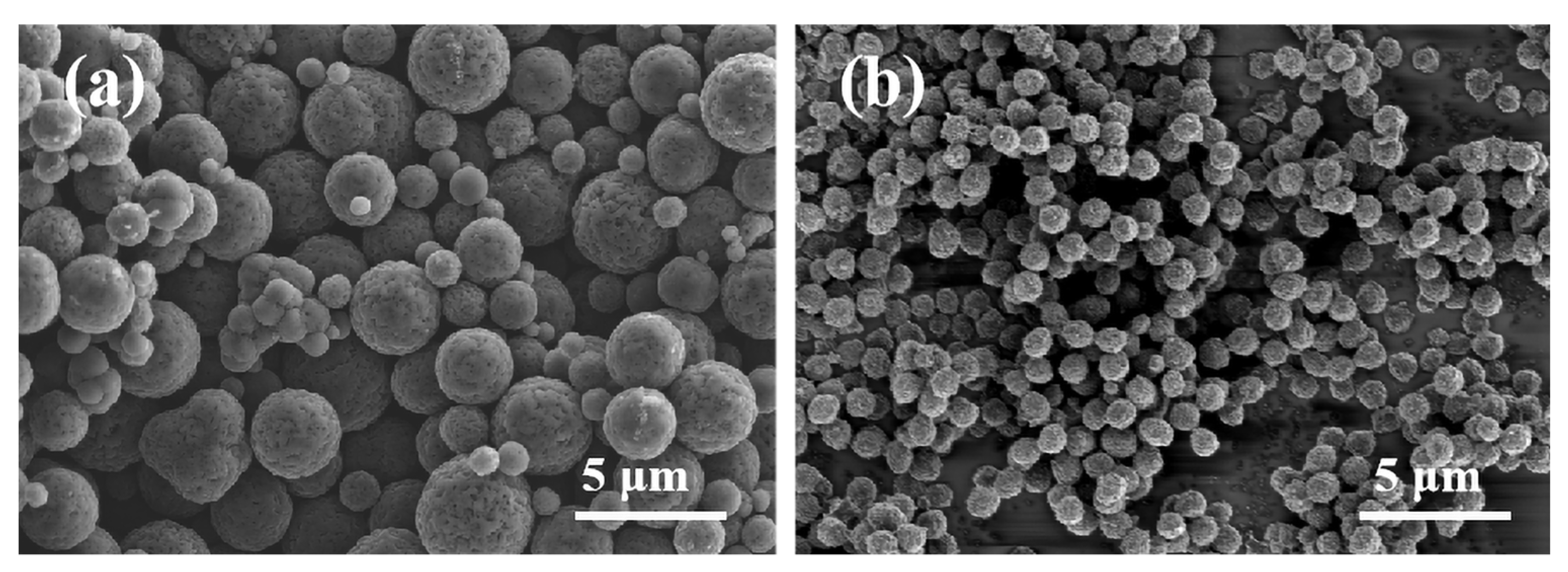
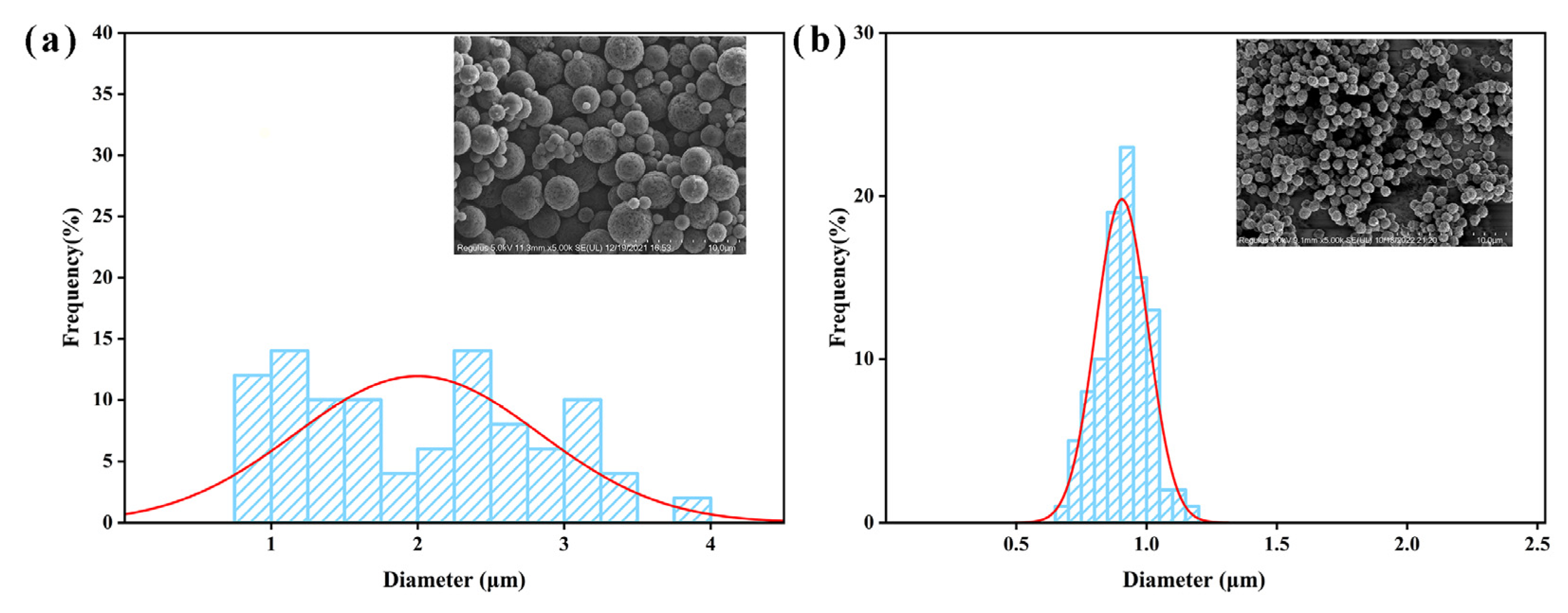


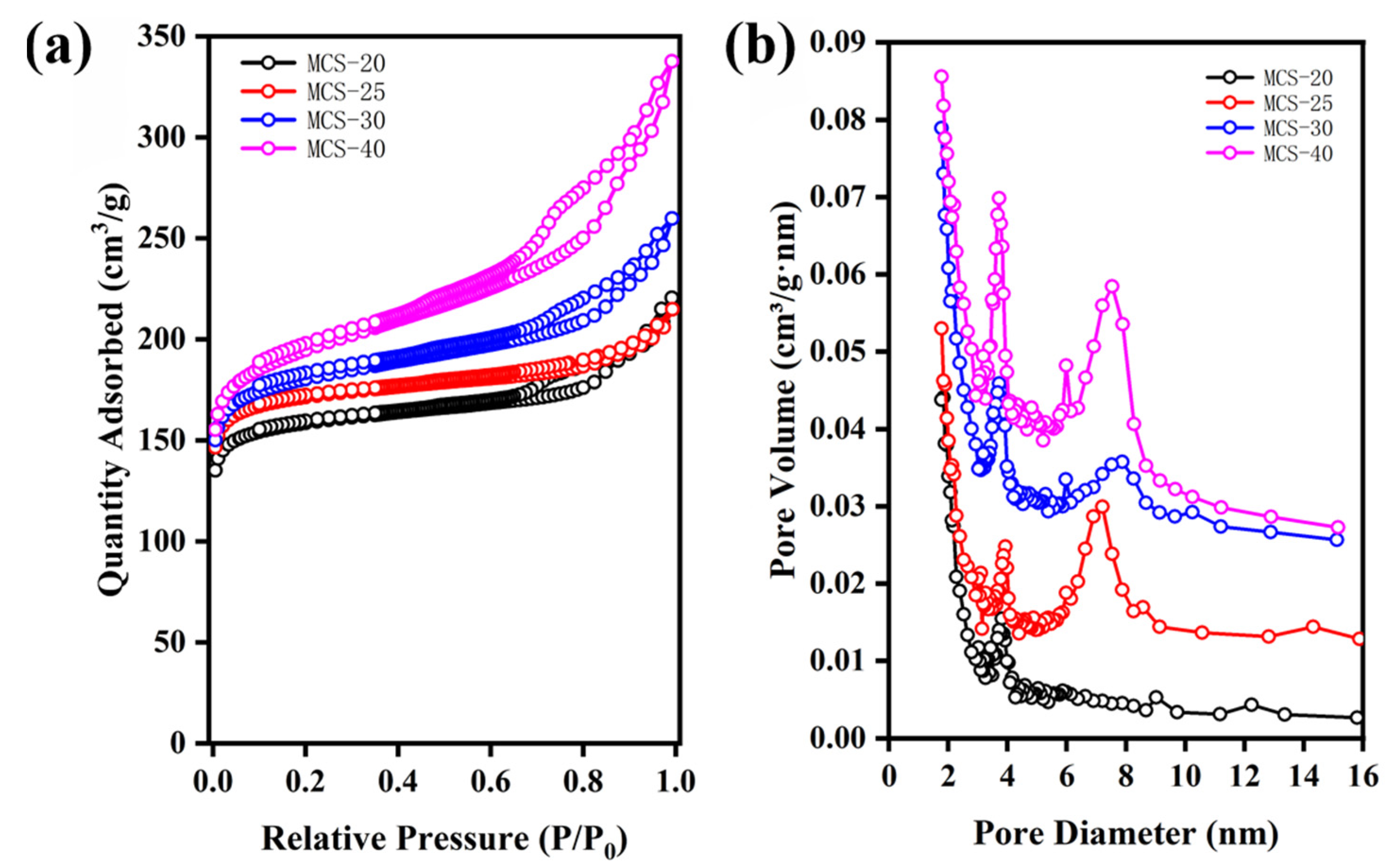
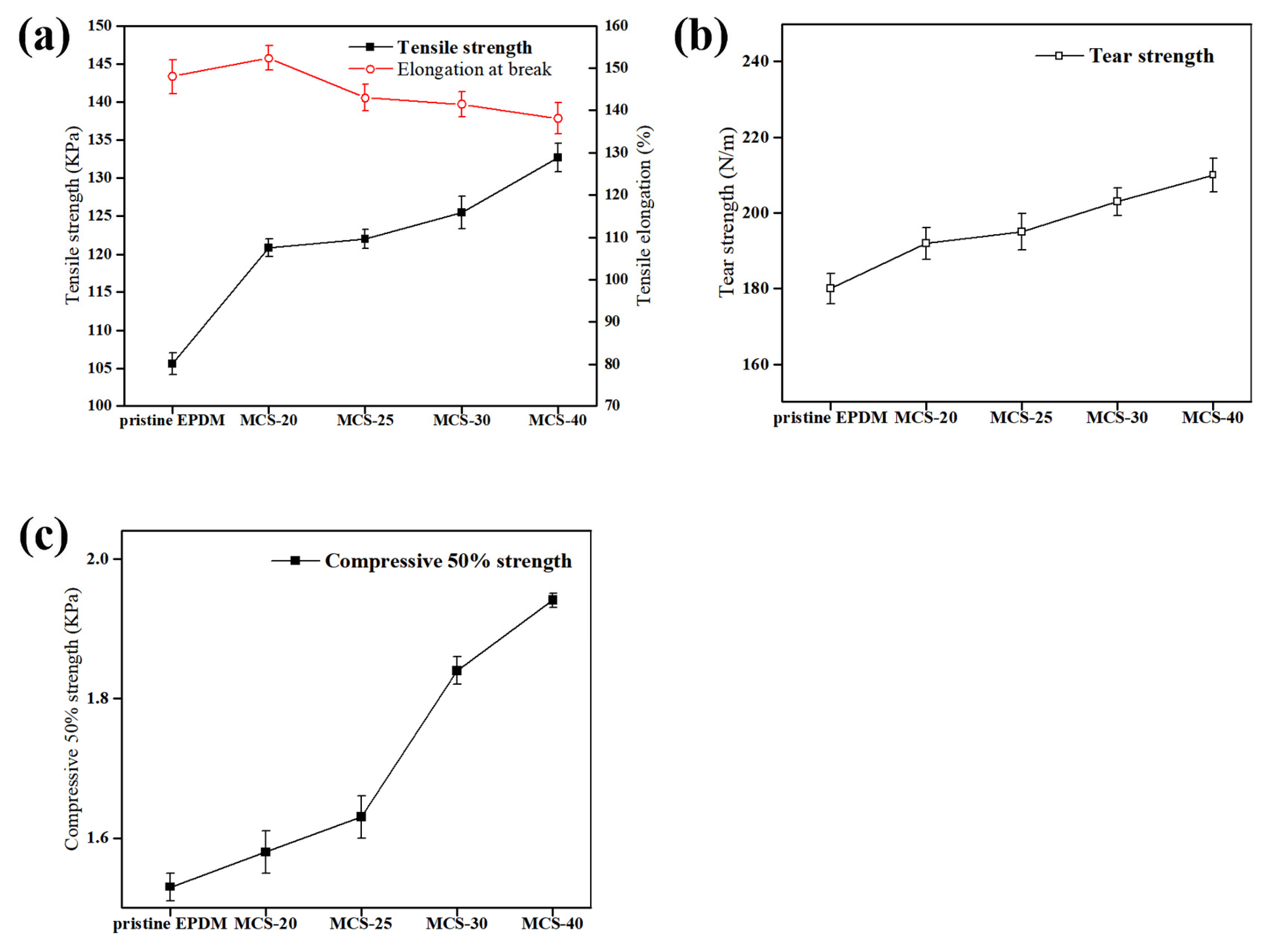
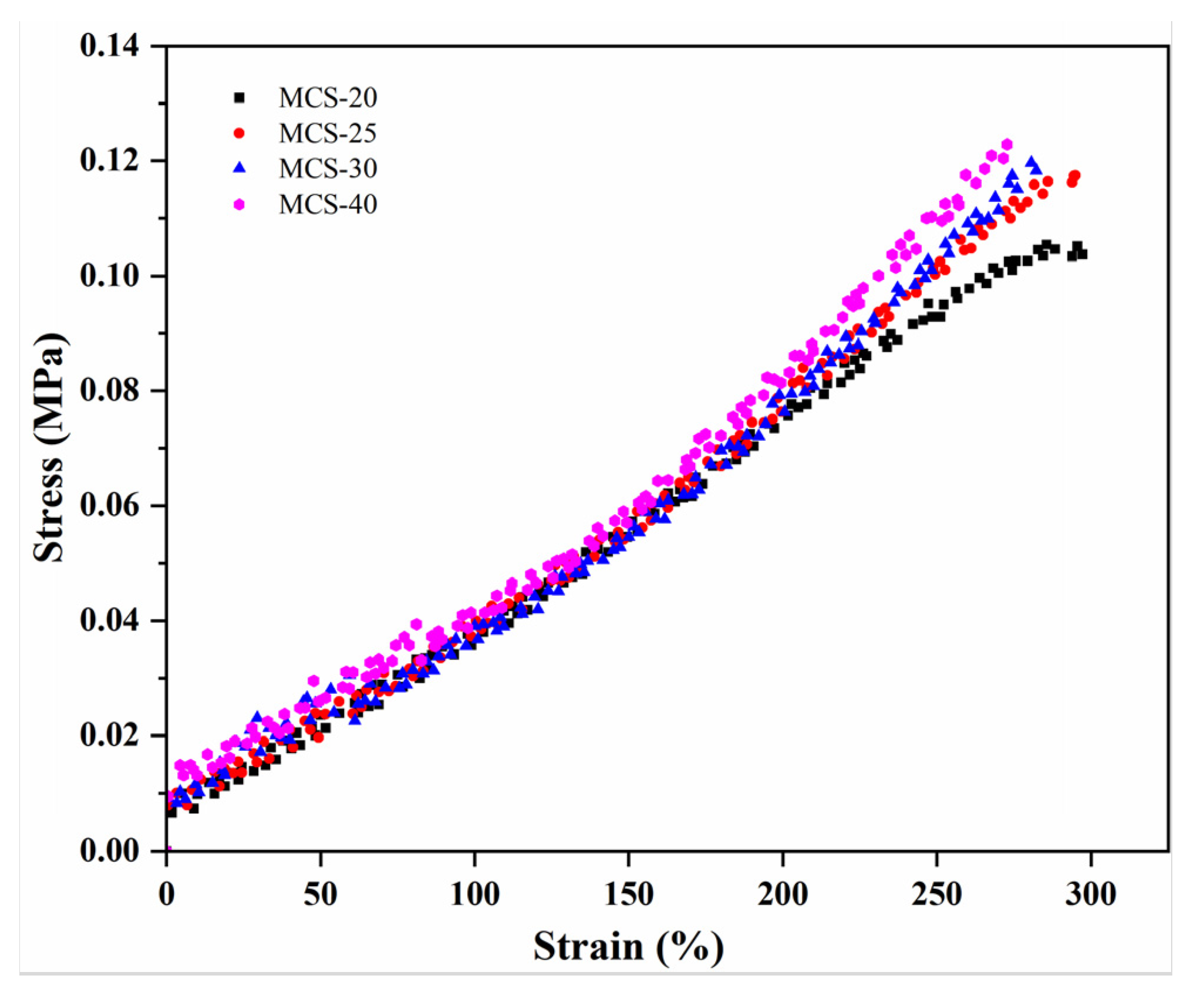

| SBET a (m2/g) | St-plot b (m2/g) | Vp c (cm3/g) | Pore Size (nm) | |
|---|---|---|---|---|
| MCS-20 | 621 | 631 | 0.33 | 3.0; 7.0 |
| MCS-25 | 673 | 582 | 0.25 | 3.0; 9.0 |
| MCS-30 | 695 | 563 | 0.40 | 3.0; 8.0 |
| MCS-40 | 735 | 529 | 0.52 | 3.0; 8.0 |
| Filler Type | |||||
|---|---|---|---|---|---|
| Pristine EPDM | MCS-20 | MCS-25 | MCS-30 | MCS-40 | |
| Tensile strength (KPa) | 105.66 (±1.42) | 120.88 (±1.17) | 122.00 (±1.24) | 125.45 (±2.15) | 132.72 (±1.83) |
| Elongation at break (%) | 148.00 (±4.07) | 152.43 (±2.99) | 143.00 (±3.08) | 141.45 (±2.97) | 138.15 (±3.62) |
| Tear strength (N/m) | 180 (±4.12) | 192 (±4.17) | 195 (±4.76) | 203 (±3.63) | 210 (±4.5) |
| Compressive 50% strength (KPa) | 1.53 (±0.02) | 1.58 (±0.03) | 1.63 (±0.03) | 1.84 (±0.02) | 1.94 (±0.01) |
Disclaimer/Publisher’s Note: The statements, opinions and data contained in all publications are solely those of the individual author(s) and contributor(s) and not of MDPI and/or the editor(s). MDPI and/or the editor(s) disclaim responsibility for any injury to people or property resulting from any ideas, methods, instructions or products referred to in the content. |
© 2024 by the authors. Licensee MDPI, Basel, Switzerland. This article is an open access article distributed under the terms and conditions of the Creative Commons Attribution (CC BY) license (https://creativecommons.org/licenses/by/4.0/).
Share and Cite
Zheng, T.; Jia, W.; Meng, H.; Li, J.; Liu, X. Synthesis of Monodisperse Mesoporous Carbon Spheres/EPDM Rubber Composites and Their Enhancement Mechanical Properties. Polymers 2024, 16, 355. https://doi.org/10.3390/polym16030355
Zheng T, Jia W, Meng H, Li J, Liu X. Synthesis of Monodisperse Mesoporous Carbon Spheres/EPDM Rubber Composites and Their Enhancement Mechanical Properties. Polymers. 2024; 16(3):355. https://doi.org/10.3390/polym16030355
Chicago/Turabian StyleZheng, Tong, Wenjing Jia, Hongjie Meng, Jiajie Li, and Xundao Liu. 2024. "Synthesis of Monodisperse Mesoporous Carbon Spheres/EPDM Rubber Composites and Their Enhancement Mechanical Properties" Polymers 16, no. 3: 355. https://doi.org/10.3390/polym16030355




